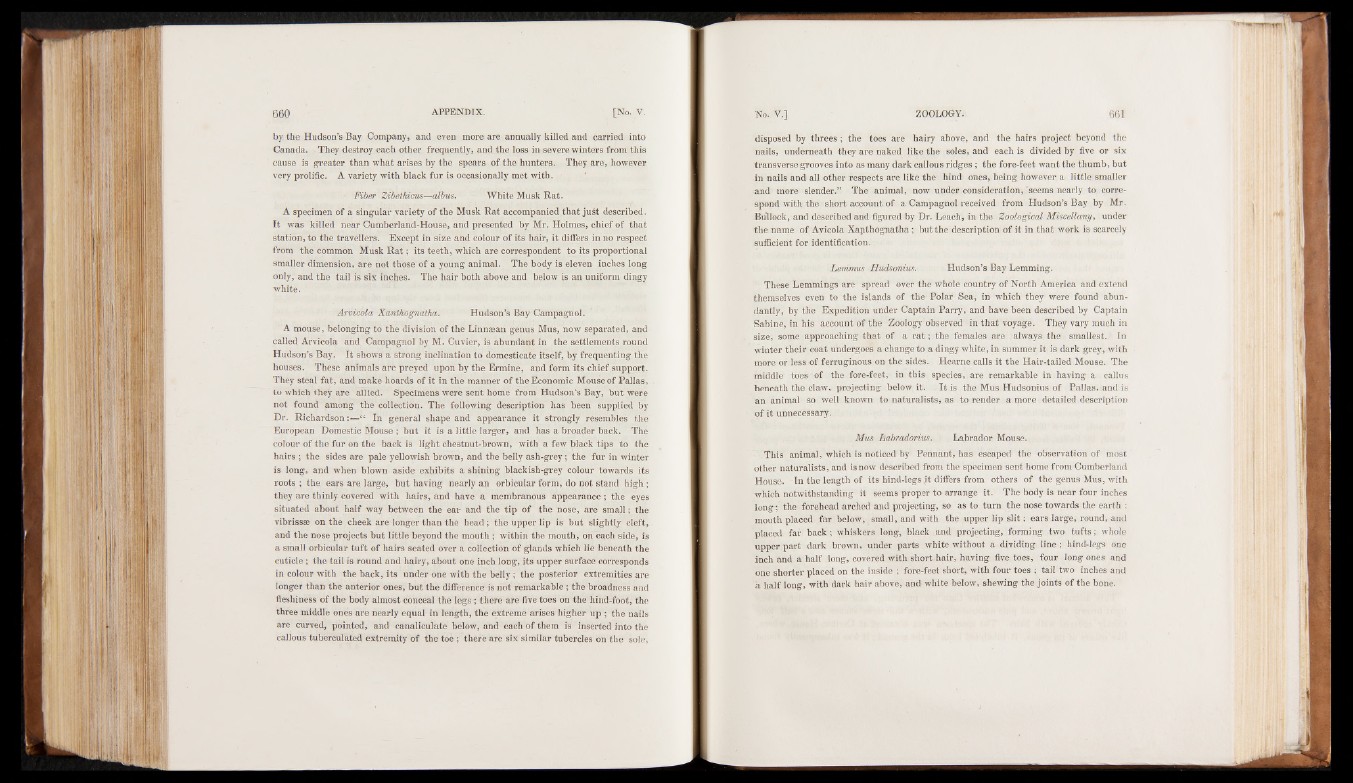
by the Hudson’s Bay Company, and even more are annually killed and carried into
Canada. They destroy each other frequently, and the loss in severe winters from this
cause is greater than what arises by the spears of the hunters. They are, however
very prolific. A variety with black fur is occasionally met with.
Fiber Zibethicus—albus. White Musk Rat.
A specimen of a singular variety of the Musk Rat accompanied that ju£t described.
It was killed near Cumberland-House, and presented by Mr. Holmes, chief of that
station, to the travellers. Except in size and colour of its hair, it differs in no respect
from the common Musk R at; its teeth, which are correspondent to its proportional
smaller dimension, are not those of a young animal. The body is eleven inches long
only, and the tail is six inches. The hair both above and below is an uniform dingy
white.
Arvicola Xanthognatka. Hudson’s Bay Campagnol.
A mouse, belonging to the division of the Linnaean genus Mus, now separated, and
called Arvicola and Campagnol by M. Cuvier, is abundant in the settlements round
Hudson’s Bay. It shows a strong inclination to domesticate itself, by frequenting the
houses. These animals are preyed upon by the Ermine, and form its chief support.
They steal fat, and make hoards of it in the manner of the Economic Mouse of Pallas,
to which they are allied. Specimens were sent home from Hudson’s Bay, but were
not found among the collection. The following description has been supplied by
Dr. Richardson:—-“ In general shape and appearance it strongly resembles the
European Domestic Mouse ; but it is a little larger, and has a broader back. The
colour of the fur on the back is light chestnut-brown, with a few black tips to the
hairs ; the sides are pale yellowish brown, and the belly ash-grey; the fur in winter
is long, and when blown aside exhibits a shining blackish-grey colour towards its
roots ; the ears are large, but having nearly an orbicular form, do not stand high ;
they are thinly covered with hairs, and have a membranous appearance; the eyes
situated about half way between the ear and the tip of the nose, are small; the
vibrissae on the cheek are longer than thè head; the upper lip is but slightly cleft,
and the nose projects but little beyond the mouth ; within the mouth, on each side, is
a small orbicular tuft of hairs seated over a collection of glands which lie beneath the
cuticle ; the tail is round and hairy, about one inch long, its upper surface corresponds
in colour with the back, its under one with the belly; the posterior extremities are
longer than the anterior ones, but the difference is not remarkable ; the broadness and
fleshiness of the body almost conceal the legs ; there are five toes on the hind-foot, the
three middle ones are nearly equal in length, the extreme arises higher up ; the nails
are curved, pointed, and canaliculate below, and each of them is inserted into the
callous tuberculated extremity of the toé ; there are six similar tubercles on the sole,
disposed by threes; the toes are hairy above, and the hairs project beyond the
nails, underneath they are naked like the soles, and each is divided by five or six
transverse grooves into as many dark callous ridges; the fore-feet want the thumb, but
in nails and all other respects are like the hind ones, being however a little smaller
and more slender.” The animal, now under consideration, "seems nearly to correspond
with the short account of a Campagnol received from Hudson’s Bay by Mr.
Bullock, and described and figured by Dr. Leach, in the Zoological Miscellany, under
the name of Avicola Xapthognatha ; but the description of it in that work is scarcely
sufficient for identification.
Lemmus Hudsonius. Hudson’s Bay Lemming.
These Lemmings are spread over the whole country of North America and extend
themselves even to the islands of the Polar Sea, in which they were found abundantly,
by the Expedition under Captain Parry, and have been described by Captain
Sabine, in his account of the Zoology observed in that voyage. They vary much in
size, some approaching that of a ra t; the females are always the smallest. In
winter their coat undergoes a change to a dingy white, in summer it is dark grey, with
more or less of ferruginous on the sides. Hearne calls it the Hair-tailed Mouse. The
middle toes of the fore-feet, in this species, are remarkable in having a callus
beneath the claw, projecting below it. It is the Mus Hudsonius of Pallas, and is
an animal so well known to naturalists, as to render a.more detailed description
of it unnecessary.
Mus Babradorius. Labrador Mouse.
This animal, which is noticed by Pennant, has escaped the observation of most
other naturalists, and is now described from the specimen sent home from Cumberland
House. In the length of its hind-legs .it differs from others of the genus Mus, with
which notwithstanding it seems proper to arrange it. The body is near four inches
long ; the forehead arched and projecting, so as to turn the nose towards the earth ;
mouth placed far below, small, and with the upper lip slit; ears large, round, and
placed far back; whiskers long, black and projecting, forming two tufts; whole
upper part dark brown, under parts white without a dividing line ; hind-legs one
inch and a half long, covered with short hair, having five toes, four long ones and
one shorter placed on the inside ; fore-feet short, with four toes ; tail two inches and
a half long, with dark hair above, and white below, shewing the joints of the bone.